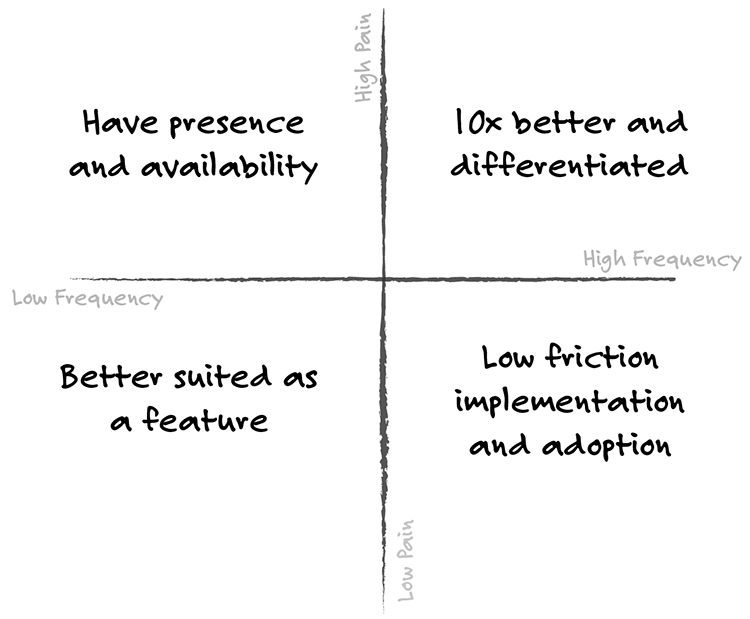This is the start of a series of blogs I want to write about the mental models that have helped me build new B2B SaaS Ventures. We use this models and framework through my work at FutureSight Ventures to validate new opportunities
How much of a pain are you solving and how often does it happen?
A popular saying in venture creation is to ‘build painkillers not vitamins’. This means that successful products are offering a solution to people with problems, whether they are aware of them or not. These problems can be judged on two dimensions: strength of pain and the frequency at which it occurs.
The Pain vs. Frequency Model helps refine how the quality of pain and the breadth of frequency will impact your go-to-market strategy.

Understanding where on the model the problem you are tackling lies will inform how you approach the market.
High Pain & Low Frequency

When a problem is high pain but low frequency, it is crucial for your product to establish a strong presence. Your strategy needs to place your product in the minds of your target market; when the pain happens, your product should be top of mind and readily available. Examples of problems in this category are infrastructure/production incidents in software that lead to downtime for customers or equipment failure in manufacturing that result in delays - potentially costing the company critical revenue and, more importantly, relationships with their customers.
A risk to keep in mind when solving a high pain, low frequency problem is that your product does not provide value when the pain is not actively being experienced. If your customers have regulatory requirements and it requires a response only during incidents, there might not be a requirement for value in between those occurrences. However, providing value in between can be a way to increase your Annual Contract Value (ACV) and generate additional benefits for your customers.
Key Takeaways
-
Position yourself as the primary and go-to solution; you are the first one the customer think of when needed
-
Have a plan to adding additional value to ensure brand value is not lost between incidences
-
Provide exceptional support to customers, ensuring that their needs are being served during a time of crisis and high pain
Low Pain & High Frequency

These are the problems that always bother you a little bit. For instance, remembering passwords or scheduling meetings. The strategy in addressing these issues is to align the effort required to use the product with the level of pain you are addressing. It should not take 5 steps to check my availability, someone else’s availability and look up an email address to send out a meeting invite.
The easier it is to implement your solution to solve their pain means that your product will be the winner in this space. However, be mindful of who has the pain and how close they are to the economic buyer. If the pain is too low then there might not be a budget to solve the problem. Along with ensuring a seamless onboarding experience, including features like free trials, effortless and intuitive as a first principle for user experience, deep integrations; your sales and marketing material should reinforce the return on investment (ROI) of the outcome you are providing.
Key Takeaways:
-
Focus on user experience by adopting a user-centric approach to create frictionless usage and adoption
-
Consider pricing models that align with a cost-effective mindset given the low pain, high frequency nature of the problem; free trials and volume-based discounts encourage adoption and usage
-
Develop a clear value proposition that effectively communicates the ROI while highlighting the efficiency and convenience of using your product
High Pain & High Frequency

It is easy to assume that High Frequency & High Pain problems should be an easy entry point for a start-up. However, when a problem is painful and happens frequently, the customer already has an existing solution in place. The ability to win here requires that you are able to provide a 10x better value or differentiator on what the customer is using today. Can you build a better mousetrap?
Some examples of solutions that exist today that successfully solved a high pain and frequency include Sales CRMs that made it easier to collect and aggregate the entire history of a lead into a shareable database that was once a spreadsheet emailed between the sales department. Another example is the rise of video-conferencing platforms during the COVID-19 pandemic, providing a vital communication tool when the vast majority of office workers were working from home.
Key Takeaways:
-
Problems here are well known and their pain is well understood; be prepared to differentiate your product, establish a unique value proposition, and continuously innovate to stay ahead.
-
Problems in this space are often critical to the organization. As founders, we need to convince leads to overcome inertia and resistance of change.
-
If you can find an underserved market that fits here: move fast and strive to be the market leader by being first before other competitors figure it out.
Low Pain & Low Frequency

These are the problems that are best suited to be value add-ons or table stakes in an existing product. Customers are unlikely to sign a purchase agreement solely based on these problems, as they are considered more of a “vitamin” rather than a core pain point. For instance, rare administrative tasks like printer paper jams fall into this category.
Key Takeaway:
- Problems here need to be paired with one of the sectors above.
The Startup Sweet Spot(s)
Understanding the pain and frequency model helps in prioritizing the type of problem you are addressing and formulating the right go-to-market strategy.
High Pain, Low Frequency requires you to be top of mind when the problem occurs and have presence so the customers will go to your solution.
Low Pain, High Frequency should focus on a user-centric approach, prioritizing frictionless onboarding experience to ensure adoption and usage of your solution.
High Pain, High Frequency may seem like an easy entry point, but you will face intense competition and entrenched home-baked solutions. You need to be 10x better OR find an underserved niche that has not yet had this solved by a vendor; bonus points if this niche is a beachhead to a larger addressable market.